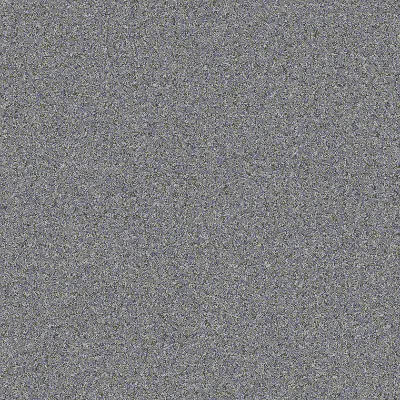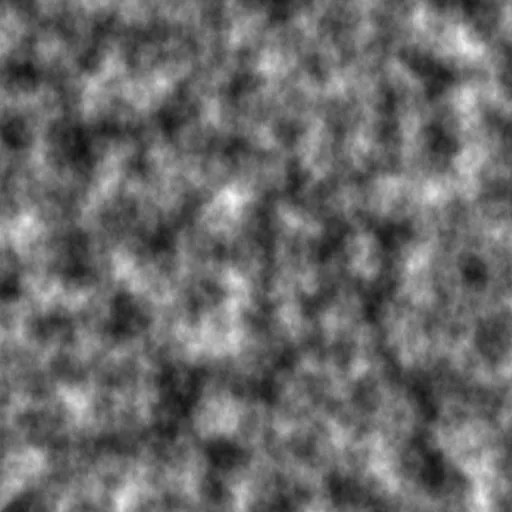我正在尝试在c++中实现Perlin噪声。
首先,问题在于输出结果并不是我所期望的。目前,我只是将生成的Perlin噪声值用于灰度图像,这就是我得到的结果: 然而,从我的理解来看,它应该更接近于以下内容:
然而,从我的理解来看,它应该更接近于以下内容:
 也就是说,我当前产生的噪声似乎更接近于“标准”的不规则噪声。
也就是说,我当前产生的噪声似乎更接近于“标准”的不规则噪声。
这是我迄今为止实现的Perlin噪声算法:
为了实现算法,我主要利用了以下两个资源:
Perlin噪声 FAQ和 Perlin噪声伪代码。
很难准确指出我的问题在哪里。可能是我生成的梯度向量不正确,因为我不确定它们应该具有什么样的分布。我尝试使用均匀分布,但似乎会在纹理中生成重复的模式!同样,我对影响值进行平均可能是不正确的。从Perlin噪声FAQ文章中很难确定应该如何做。请问有人能给我关于代码哪里出了问题的提示吗? :)
首先,问题在于输出结果并不是我所期望的。目前,我只是将生成的Perlin噪声值用于灰度图像,这就是我得到的结果:
 然而,从我的理解来看,它应该更接近于以下内容:
然而,从我的理解来看,它应该更接近于以下内容:
 也就是说,我当前产生的噪声似乎更接近于“标准”的不规则噪声。
也就是说,我当前产生的噪声似乎更接近于“标准”的不规则噪声。这是我迄今为止实现的Perlin噪声算法:
float perlinNoise2D(float x, float y)
{
// Find grid cell coordinates
int x0 = (x > 0.0f ? static_cast<int>(x) : (static_cast<int>(x) - 1));
int x1 = x0 + 1;
int y0 = (y > 0.0f ? static_cast<int>(y) : (static_cast<int>(y) - 1));
int y1 = y0 + 1;
float s = calculateInfluence(x0, y0, x, y);
float t = calculateInfluence(x1, y0, x, y);
float u = calculateInfluence(x0, y1, x, y);
float v = calculateInfluence(x1, y1, x, y);
// Local position in the grid cell
float localPosX = 3 * ((x - (float)x0) * (x - (float)x0)) - 2 * ((x - (float)x0) * (x - (float)x0) * (x - (float)x0));
float localPosY = 3 * ((y - (float)y0) * (y - (float)y0)) - 2 * ((y - (float)y0) * (y - (float)y0) * (y - (float)y0));
float a = s + localPosX * (t - s);
float b = u + localPosX * (v - u);
return lerp(a, b, localPosY);
}
calculateInfluence 函数的作用是为当前网格单元的一个角点生成随机梯度向量和距离向量,并返回这两个向量的点积。其实现方式如下:
float calculateInfluence(int xGrid, int yGrid, float x, float y)
{
// Calculate gradient vector
float gradientXComponent = dist(rdEngine);
float gradientYComponent = dist(rdEngine);
// Normalize gradient vector
float magnitude = sqrt( pow(gradientXComponent, 2) + pow(gradientYComponent, 2) );
gradientXComponent = gradientXComponent / magnitude;
gradientYComponent = gradientYComponent / magnitude;
magnitude = sqrt(pow(gradientXComponent, 2) + pow(gradientYComponent, 2));
// Calculate distance vectors
float dx = x - (float)xGrid;
float dy = y - (float)yGrid;
// Compute dot product
return (dx * gradientXComponent + dy * gradientYComponent);
}
在这里,dist 是 C++11 中的一个随机数生成器:
std::mt19937 rdEngine(1);
std::normal_distribution<float> dist(0.0f, 1.0f);
而 lerp 只需简单实现为:
float lerp(float v0, float v1, float t)
{
return ( 1.0f - t ) * v0 + t * v1;
}
为了实现算法,我主要利用了以下两个资源:
Perlin噪声 FAQ和 Perlin噪声伪代码。
很难准确指出我的问题在哪里。可能是我生成的梯度向量不正确,因为我不确定它们应该具有什么样的分布。我尝试使用均匀分布,但似乎会在纹理中生成重复的模式!同样,我对影响值进行平均可能是不正确的。从Perlin噪声FAQ文章中很难确定应该如何做。请问有人能给我关于代码哪里出了问题的提示吗? :)